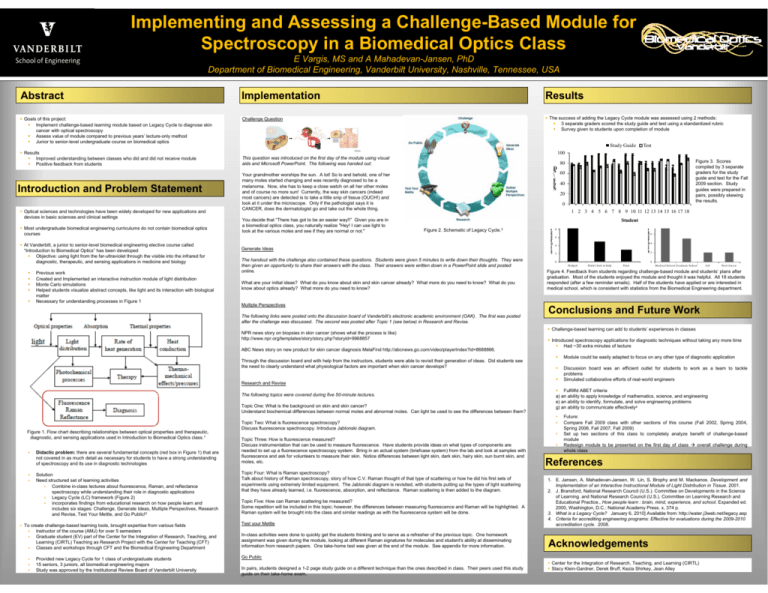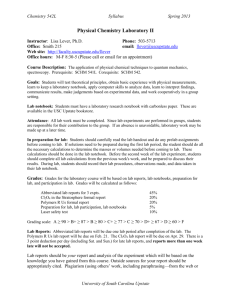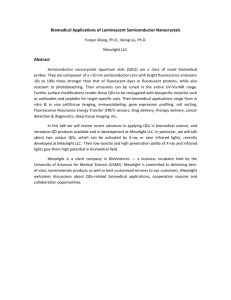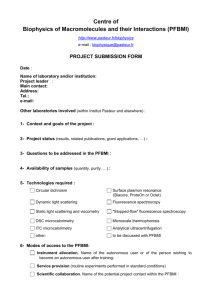Poster
advertisement

Implementing and Assessing a Challenge-Based Module for Spectroscopy in a Biomedical Optics Class E Vargis, MS and A Mahadevan-Jansen, PhD Department of Biomedical Engineering, Vanderbilt University, Nashville, Tennessee, USA Abstract Implementation Results Goals of this project: Implement challenge-based learning module based on Legacy Cycle to diagnose skin cancer with optical spectroscopy Assess value of module compared to previous years’ lecture-only method Junior to senior-level undergraduate course on biomedical optics Challenge Question The success of adding the Legacy Cycle module was assessed using 2 methods: 3 separate graders scored the study guide and test using a standardized rubric Survey given to students upon completion of module Results Improved understanding between classes who did and did not receive module Positive feedback from students Introduction and Problem Statement Optical sciences and technologies have been widely developed for new applications and devices in basic sciences and clinical settings Most undergraduate biomedical engineering curriculums do not contain biomedical optics courses At Vanderbilt, a junior to senior-level biomedical engineering elective course called “Introduction to Biomedical Optics” has been developed Objective: using light from the far-ultraviolet through the visible into the infrared for diagnostic, therapeutic, and sensing applications in medicine and biology Previous work Created and Implemented an interactive instruction module of light distribution Monte Carlo simulations Helped students visualize abstract concepts, like light and its interaction with biological matter Necessary for understanding processes in Figure 1 Study Guide You decide that “There has got to be an easier way!!” Given you are in a biomedical optics class, you naturally realize "Hey! I can use light to look at the various moles and see if they are normal or not." 0 1 2 3 4 5 6 7 8 9 10 11 12 13 14 15 16 17 18 8 Figure 2. Schematic of Legacy Cycle.3 Generate Ideas The handout with the challenge also contained these questions. Students were given 5 minutes to write down their thoughts. They were then given an opportunity to share their answers with the class. Their answers were written down in a PowerPoint slide and posted online. What are your initial ideas? What do you know about skin and skin cancer already? What more do you need to know? What do you know about optics already? What more do you need to know? Multiple Perspectives ABC News story on new product for skin cancer diagnosis MelaFind http://abcnews.go.com/video/playerIndex?id=8688866. Through the discussion board and with help from the instructors, students were able to revisit their generation of ideas. Did students see the need to clearly understand what physiological factors are important when skin cancer develops? Research and Revise The following topics were covered during five 50-minute lectures. Topic One: What is the background on skin and skin cancer? Understand biochemical differences between normal moles and abnormal moles. Can light be used to see the differences between them? Didactic problem: there are several fundamental concepts (red box in Figure 1) that are not covered in as much detail as necessary for students to have a strong understanding of spectroscopy and its use in diagnostic technologies Solution Need structured set of learning activities Combine in-class lectures about fluorescence, Raman, and reflectance spectroscopy while understanding their role in diagnostic applications Legacy Cycle (LC) framework (Figure 2) incorporates findings from educational research on how people learn and includes six stages: Challenge, Generate Ideas, Multiple Perspectives, Research and Revise, Test Your Mettle, and Go Public! 2 To create challenge-based learning tools, brought expertise from various fields Instructor of the course (AMJ) for over 5 semesters Graduate student (EV) part of the Center for the Integration of Research, Teaching, and Learning (CIRTL) Teaching as Research Project with the Center for Teaching (CFT) Classes and workshops through CFT and the Biomedical Engineering Department Provided new Legacy Cycle for 1 class of undergraduate students 15 seniors, 3 juniors, all biomedical engineering majors Study was approved by the Institutional Review Board of Vanderbilt University Student 10 NPR news story on biopsies in skin cancer (shows what the process is like) http://www.npr.org/templates/story/story.php?storyId=9968857 Figure 3. Scores compiled by 3 separate graders for the study guide and test for the Fall 2009 section. Study guides were prepared in pairs, possibly skewing the results. 80 D S 60 \ er oc 40 S 20 Your grandmother worships the sun. A lot! So lo and behold, one of her many moles started changing and was recently diagnosed to be a melanoma. Now, she has to keep a close watch on all her other moles and of course no more sun! Currently, the way skin cancers (indeed most cancers) are detected is to take a little snip of tissue (OUCH!) and look at it under the microscope. Only if the pathologist says it is CANCER, does the dermatologist go and take out the whole thing. The following links were posted onto the discussion board of Vanderbilt’s electronic academic environment (OAK). The first was posted after the challenge was discussed. The second was posted after Topic 1 (see below) in Research and Revise. Figure 1. Flow chart describing relationships between optical properties and therapeutic, diagnostic, and sensing applications used in Introduction to Biomedical Optics class.1 Test 100 This question was introduced on the first day of the module using visual aids and Microsoft PowerPoint. The following was handed out: Topic Two: What is fluorescence spectroscopy? Discuss fluorescence spectroscopy. Introduce Jablonski diagram. ts en d n o p se R ey rv u S 6 4 2 0 Topic Four: What is Raman spectroscopy? Talk about history of Raman spectroscopy, story of how C.V. Raman thought of that type of scattering or how he did his first sets of experiments using extremely limited equipment. The Jablonski diagram is revisited, with students putting up the types of light scattering that they have already learned, i.e. fluorescence, absorption, and reflectance. Raman scattering is then added to the diagram. 0 H elped D id n't hurt or help H urt Me d ica l Sc h o ol G rad u a te Scho ol Jo b D o n 't k n o w Figure 4. Feedback from students regarding challenge-based module and students’ plans after graduation. Most of the students enjoyed the module and thought it was helpful. All 18 students responded (after a few reminder emails). Half of the students have applied or are interested in medical school, which is consistent with statistics from the Biomedical Engineering department. Conclusions and Future Work Challenge-based learning can add to students’ experiences in classes Introduced spectroscopy applications for diagnostic techniques without taking any more time Had ~30 extra minutes of lecture Module could be easily adapted to focus on any other type of diagnostic application Discussion board was an efficient outlet for students to work as a team to tackle problems Simulated collaborative efforts of real-world engineers Fulfillfd ABET criteria a) an ability to apply knowledge of mathematics, science, and engineering e) an ability to identify, formulate, and solve engineering problems g) an ability to communicate effectively4 • • • Topic Three: How is fluorescence measured? Discuss instrumentation that can be used to measure fluorescence. Have students provide ideas on what types of components are needed to set up a fluorescence spectroscopy system. Bring in an actual system (briefcase system) from the lab and look at samples with fluorescence and ask for volunteers to measure their skin. Notice differences between light skin, dark skin, hairy skin, sun burnt skin, and moles, etc. ts en 6 d n o p se R4 ey rv u S2 8 • Future: Compare Fall 2009 class with other sections of this course (Fall 2002, Spring 2004, Spring 2006, Fall 2007, Fall 2009) Set up two sections of this class to completely analyze benefit of challenge-based module Redesign module to be presented on the first day of class Æ overall challenge during whole class References Test your Mettle 1. E. Jansen, A. Mahadevan-Jansen, W. Lin, S. Brophy and M. Mackanos. Development and Implementation of an Interactive Instructional Module of Light Distribution in Tissue. 2001. 2. J. Bransford, National Research Council (U.S.). Committee on Developments in the Science of Learning. and National Research Council (U.S.). Committee on Learning Research and Educational Practice., How people learn : brain, mind, experience, and school. Expanded ed. 2000, Washington, D.C.: National Academy Press. x, 374 p. 3. What is a Legacy Cycle? January 6, 2010] Available from: http://water.j3web.net/legacy.asp 4. Criteria for accrediting engineering programs: Effective for evaluations during the 2009-2010 accreditation cycle. 2008. In-class activities were done to quickly get the students thinking and to serve as a refresher of the previous topic. One homework assignment was given during the module, looking at different Raman signatures for molecules and student's ability at disseminating information from research papers. One take-home test was given at the end of the module. See appendix for more information. Acknowledgements Topic Five: How can Raman scattering be measured? Some repetition will be included in this topic; however, the differences between measuring fluorescence and Raman will be highlighted. A Raman system will be brought into the class and similar readings as with the fluorescence system will be done. Go Public In pairs, students designed a 1-2 page study guide on a different technique than the ones described in class. Their peers used this study guide on their take-home exam. Center for the Integration of Research, Teaching, and Learning (CIRTL) Stacy Klein-Gardner, Derek Bruff, Kezia Shirkey, Jean Alley





